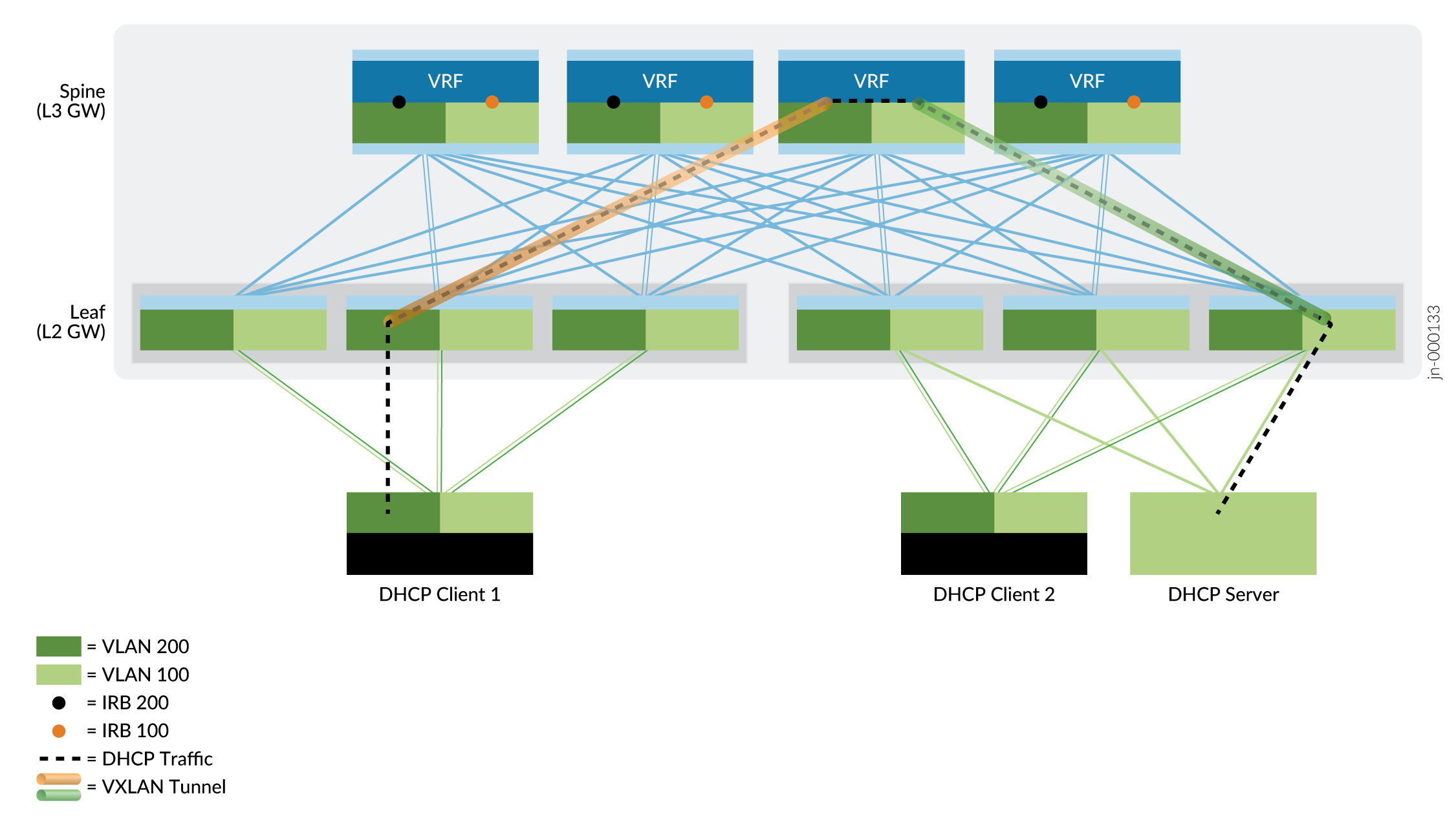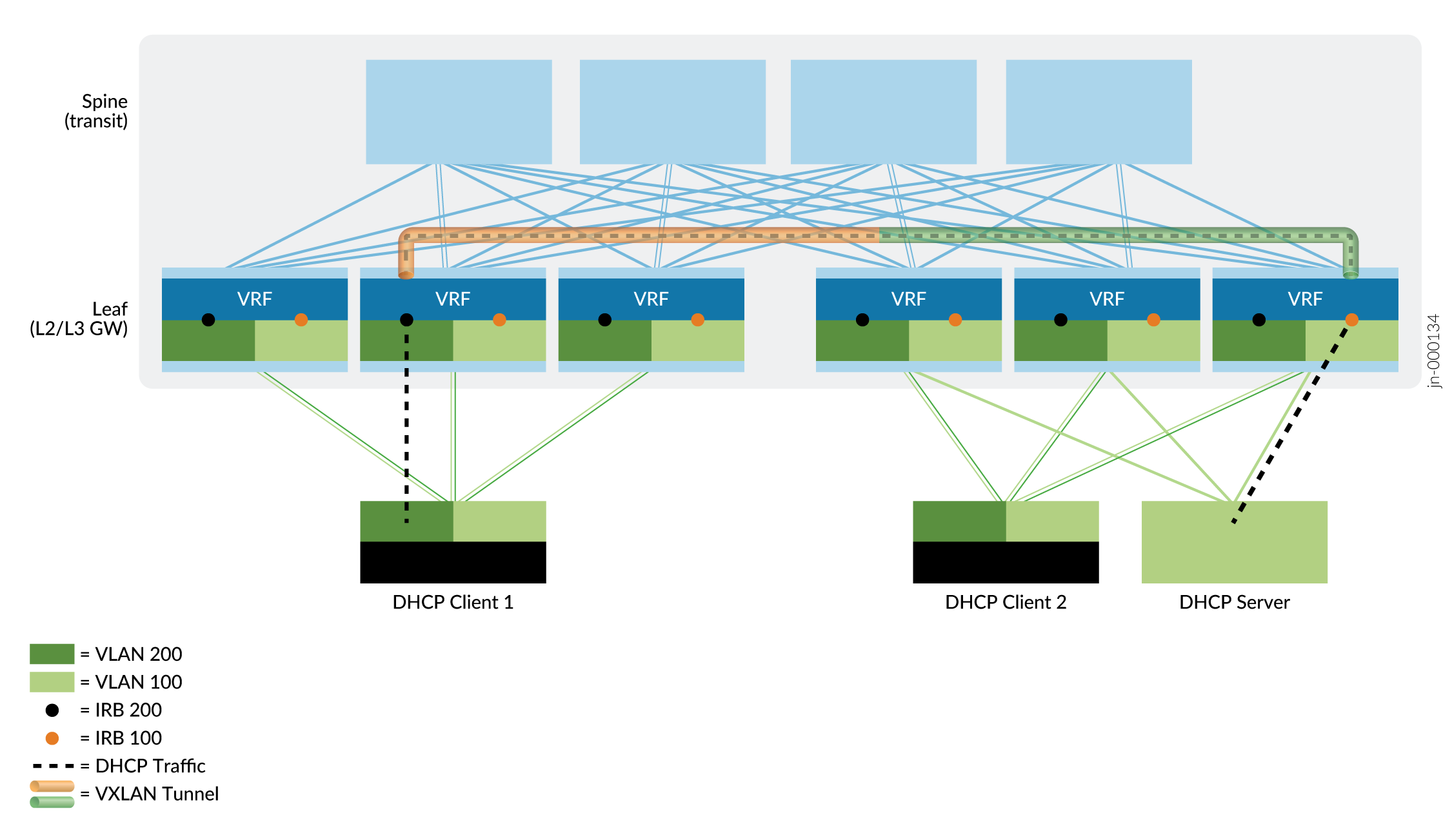- play_arrow EVPN-VXLAN
- play_arrow Overview
- Understanding EVPN with VXLAN Data Plane Encapsulation
- EVPN-over-VXLAN Supported Functionality
- Understanding VXLANs
- VXLAN Constraints on EX Series, QFX Series, PTX Series, and ACX Series Devices
- EVPN Over VXLAN Encapsulation Configuration Overview for QFX Series and EX4600 Switches
- Implementing EVPN-VXLAN for Data Centers
- PIM NSR and Unified ISSU Support for VXLAN Overview
- Routing IPv6 Data Traffic through an EVPN-VXLAN Network with an IPv4 Underlay
- Understanding How to Configure VXLANs and Layer 3 Logical Interfaces to Interoperate
- Understanding GBP Profiles
- play_arrow Configuring EVPN-VXLAN Interfaces
- Understanding Flexible Ethernet Services Support With EVPN-VXLAN
- EVPN-VXLAN Lightweight Leaf to Server Loop Detection
- Overlapping VLAN Support Using VLAN Translation in EVPN-VXLAN Networks
- Overlapping VLAN Support Using Multiple Forwarding Instances or VLAN Normalization
- Layer 2 Protocol Tunneling over VXLAN Tunnels in EVPN-VXLAN Bridged Overlay Networks
- MAC Filtering, Storm Control, and Port Mirroring Support in an EVPN-VXLAN Environment
- Example: Micro and Macro Segmentation using Group Based Policy in a VXLAN
- DHCP Smart Relay in EVPN-VXLAN
- play_arrow Configuring VLAN-Aware Bundle Services, VLAN-Based Services, and Virtual Switch Support
- play_arrow Load Balancing with EVPN-VXLAN Multihoming
- play_arrow Setting Up a Layer 3 VXLAN Gateway
- play_arrow Configuring an EVPN-VXLAN Centrally-Routed Bridged Overlay
- play_arrow Configuring an EVPN-VXLAN Edge-Routed Bridging Overlay
- play_arrow IPv6 Underlay for VXLAN Overlays
- play_arrow Multicast Features with EVPN-VXLAN
- Multicast Support in EVPN-VXLAN Overlay Networks
- Overview of Multicast Forwarding with IGMP Snooping or MLD Snooping in an EVPN-VXLAN Environment
- Example: Preserving Bandwidth with IGMP Snooping in an EVPN-VXLAN Environment
- Overview of Selective Multicast Forwarding
- Configuring the number of SMET Nexthops
- Assisted Replication Multicast Optimization in EVPN Networks
- Optimized Intersubnet Multicast in EVPN Networks
- play_arrow Configuring the Tunneling of Q-in-Q Traffic
- play_arrow Tunnel Traffic Inspection on SRX Series Devices
- play_arrow Fault Detection and Isolation in EVPN-VXLAN Fabrics
-
- play_arrow EVPN-MPLS
- play_arrow Overview
- play_arrow Convergence in an EVPN MPLS Network
- play_arrow Pseudowire Termination at an EVPN
- play_arrow Configuring the Distribution of Routes
- Configuring an IGP on the PE and P Routers on EX9200 Switches
- Configuring IBGP Sessions Between PE Routers in VPNs on EX9200 Switches
- Configuring a Signaling Protocol and LSPs for VPNs on EX9200 Switches
- Configuring Entropy Labels
- Configuring Control Word for EVPN-MPLS
- Understanding P2MPs LSP for the EVPN Inclusive Provider Tunnel
- Configuring Bud Node Support
- play_arrow Configuring VLAN Services and Virtual Switch Support
- play_arrow Configuring Integrated Bridging and Routing
- EVPN with IRB Solution Overview
- An EVPN with IRB Solution on EX9200 Switches Overview
- Anycast Gateways
- Configuring EVPN with IRB Solution
- Configuring an EVPN with IRB Solution on EX9200 Switches
- Example: Configuring EVPN with IRB Solution
- Example: Configuring an EVPN with IRB Solution on EX9200 Switches
- play_arrow Configuring IGMP or MLD Snooping with EVPN-MPLS
-
- play_arrow EVPN E-LAN Services
- play_arrow EVPN-VPWS
- play_arrow Configuring VPWS Service with EVPN Mechanisms
- Overview of VPWS with EVPN Signaling Mechanisms
- Control word for EVPN-VPWS
- Overview of Flexible Cross-Connect Support on VPWS with EVPN
- Overview of Headend Termination for EVPN VPWS for Business Services
- Configuring VPWS with EVPN Signaling Mechanisms
- Example: Configuring VPWS with EVPN Signaling Mechanisms
- FAT Flow Labels in EVPN-VPWS Routing Instances
- Configuring EVPN-VPWS over SRv6
- Configuring Micro-SIDs in EVPN-VPWS
-
- play_arrow EVPN-ETREE
- play_arrow Overview
- play_arrow Configuring EVPN-ETREE
-
- play_arrow Using EVPN for Interconnection
- play_arrow Interconnecting VXLAN Data Centers With EVPN
- play_arrow Interconnecting EVPN-VXLAN Data Centers Through an EVPN-MPLS WAN
- play_arrow Extending a Junos Fusion Enterprise Using EVPN-MPLS
-
- play_arrow PBB-EVPN
- play_arrow Configuring PBB-EVPN Integration
- play_arrow Configuring MAC Pinning for PBB-EVPNs
-
- play_arrow EVPN Standards
- play_arrow Supported EVPN Standards
-
- play_arrow VXLAN-Only Features
- play_arrow Flexible VXLAN Tunnels
- play_arrow Static VXLAN
-
- play_arrow Configuration Statements and Operational Commands
DHCP Relay Agent over EVPN-VXLAN
Dynamic Host Configuration Protocol (DHCP) is a protocol that enables a DHCP server to dynamically allocate IP addresses to DHCP clients. This allows you to manage IP addresses and other network configurations easily. The DHCP relay agent forward DHCP messages between DHCP clients and DHCP servers when they are on different networks. Junos supports configuring the DHCP relay agent in an EVPN-VXLAN fabric.
In an EVPN-VXLAN fabric, the DHCP server and the DHCP clients connect into the network using access interfaces on leaf devices. The DHCP server and clients can communicate with each other over the existing network without further configuration when the DHCP client and server are in the same VLAN. When a DHCP client and server are in different VLANs, DHCP traffic between the client and server is forwarded between the VLANs through integrated routing and bridging (IRB) interfaces.
You can configure DHCP relay on a centrally-routed bridging overlay or on an edge-routed bridging overlay in an EVPN-VXLAN fabric. The main difference between the overlay models for DHCP relay configuration is the IRB interfaces. In a centrally-routed bridging overlay, these IRB interfaces are on the spine devices, while in an edge-routed bridging overlay, they are on the leaf devices.
DHCP relay is supported in EVPN-VXLAN fabrics with IPv6 underlay. For information on IPv6 underlay, see EVPN-VXLAN with an IPv6 Underlay.
DHCP Relay on a Centrally-routed Bridging Overlay
In a centrally-routed briding overlay, the spine devices function as Layer 3 gateways that handle traffic between VXLANs while the leaf devices function as Layer 2 gateways that handle traffic within a VXLAN. DHCP clients are connected to pure Layer 2 EVPN leaf devices. DHCP packets are sent over the EVPN core towards spine devices, which function as DHCP relay agents, forwarding the packets to the servers. Configuring DHCP relay on the spine devices of a centrally-routed bridging overlay allows you to simplify and centralize the routing of the DHCP messages.
Figure 1 shows how DHCP traffic is forwarded in a centrally-routed bridging overlay where the DHCP client and server connect to access interfaces on different leaf devices in different VLANs. For information on how to configure DHCP relay in a centrally-routed bridging overlay, see DHCP Relay Design and Implementation.

DHCP Relay on an Edge-routed Bridging Overlay
In an edge-routed bridging overlay, the leaf devices serve as both Layer 2 and Layer 3 gateways. All leaf devices support IRB functionality and function as VTEPs to establish VXLAN tunnels. Spine devices are configured to handle only IP traffic, which removes the need to extend the bridging overlays to the spine devices.
Figure 2 shows how DHCP traffic is forwarded in an edge-routed bridging overlay where the DHCP client and server connect to access interfaces on different leaf devices in different VLANs. For more information on configuring DHCP relay in an edge-routed briding overlay, see Configure a DHCP Relay in EVPN-VXLAN Fabric Architecture.





















